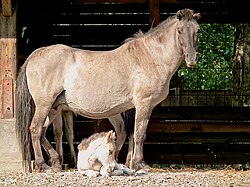Rear horse
| Rear horse | |
|---|---|

Heck horse mare with foal in the Rheingönheim Wildlife Park |
|
| Important data | |
| Origin: | Germany |
| Main breeding area: | Germany |
| Distribution: | Central Europe |
| Stick measure : | 140 cm |
| Colors : | light mouse falcons , rarely with zebra stripes on the legs, rarely brown ones , mold , white markings on the head |
| Main application area: | Zoos , extensive agriculture |
The Heckpferd is a cross between different European pony and horse breeds . The brothers Heinz and Lutz Heck tried to breed a horse that, in their imagination, resembles the extinct Tarpan wild horse.
Breeding history and appearance

Heck horses are mousefolds with a dark eel line , the color of the fur becomes darker towards the mouth and the tips of the legs. Slight leg stripes are also rarely seen. The mane and tail hair are composed of light and dark hair.
In the 1930s and 1940s, the Heck brothers crossed mares of the Dülmen horse , Koniks , Icelandic ponies , and gray-white Gotland pony mares with Przewalski horse stallions. The Koniks used for breeding were bought from peasants from Poland during the Second World War , expropriated or evacuated from the front. After the war, Heck horses continued to be crossed with Koniks. Different colors were used for breeding, so that in addition to the typical mouse fallow, other colors occasionally appear in the Heck horse. The rear horse is larger and more delicate than the Konik horse.
In the bison enclosure Hardehausen in North Rhine-Westphalia , rear horses were later crossed repeatedly with Przewalski horses in order to obtain a standing mane. This is based on the assumption that the European wild horse also had one, but this is unlikely. In the climate of post-glacial Europe, a hammock had the advantage that it drains away rainwater, and ice-age horse mummies are known that have a hammock.
The Heck horses in Hellabrunn Zoo , where Heinz Heck was the zoo director in the 1930s, were no longer crossbred and correspond to the type that the Heck brothers bred.
The Dülmen horse was also crossed with Koniks on a large scale. Sometimes it is combined with the Heckpferd and the Konik to form the Konik group .
use
Rear horses are not uncommon to be found in Central European zoos, almost always under the misnomer "Tarpan". This is because the Heck brothers (similar to the Heck cattle ) believed that their breeding attempts were indeed bringing back an extinct wild animal and baptized their breeds accordingly, regardless of scientific opinion. However, since this is a robust landrace, rear horses are often used in grazing projects for nature conservation reasons , because grazing by grazing cattle retains the encroachment of open areas. However, the erroneous identification with the wild horse persists.
Individual evidence
- ↑ a b c Bunzel-Drüke, Finck, Kämmer, Luick, Reisinger, Riecken, Riedl, Scharf & Zimball: "Wild pastures: Practical guidelines for year-round grazing in nature conservation and landscape development"
- ^ Tadeusz Jezierski, Zbigniew Jaworski: The Polish Konik. Die Neue Brehm-Bücherei Vol. 658 , Westarp Sciences, Hohenwarsleben 2008, ISBN 3-89432-913-0 .
- ↑ Wild horses for Europe - which breed is the best?